麦肯锡面试指南超值啊
- 格式:doc
- 大小:50.51 KB
- 文档页数:6

【海归找工作】麦肯锡面经大全访谈Q:首先感谢学姐能够参与到我们这次活动中,能否先简要介绍一下你加入麦肯锡公司的求职经历?A:我是06年7月加入公司的,应该是05年底参加面试的,我们当时面试的时间很长,我是面试JIA的,我们这界面试7轮大概拖了有2个多月快2个半月,我们以后的面试就和我们不一样了,我们下一届应该是面试2天就可以了。
你是想知道我的面试流程还是之后的?Q:还是希望了解一下您个人的经历。
A:第一轮是Pretalk,就是打个电话简短地聊一下。
那个其实也蛮突然的,我好像还在逛街,突然接到这个电话。
几个tips,第一个是你的声音要比较正定,你要找个安静的地方。
因为当时接电话之后他说要和我Pretalk那时我在商场里面比较吵,那我就和他说可不可以过5分钟再打来,然后我就马上在商场里面找了个安全通道那里比较安静,而且我觉得这样给对方听起来印象会比较好吧,如果你在电话那方乱哄哄的对方也觉得不是很清楚,这样会比较重视。
我记得他当时问题大概就2、3个吧,大概首先让你用英文简短地介绍一下你自己,然后问你为什么申请这个职位,反正就是3个最简单的问题。
其实我觉得第一个打来的人是最开始的HR,他也不会对你有什么特别高的要求。
我觉得他就是看这个人的说话态度感觉是不是很诚恳,是不是一个比较沉稳的一个人;第二是看你英语是不是比较好,第三是看你是不是能够说出一点内容而不是愣在那边什么都说不出来。
我觉得主要是考察语言和你这整个人说话流露出来那种感觉,他觉得ok,那就过了。
第二轮好像是在公司里面对面见了一个比较有新一点的同事,过去之后每个人都很短暂大概15到20分钟的样子,就是让你先介绍一下自己,然后做了2个很小的Case,反正面试咨询的同学应该都知道有这种Case Interview,一个是想考察一下你的思维角度,他当时问的问题是比较常见的那种,一个是“请你衡量一下上海有多少个加油站。
”,我觉得这种考察的是你的思维还有最简单的数字计算。
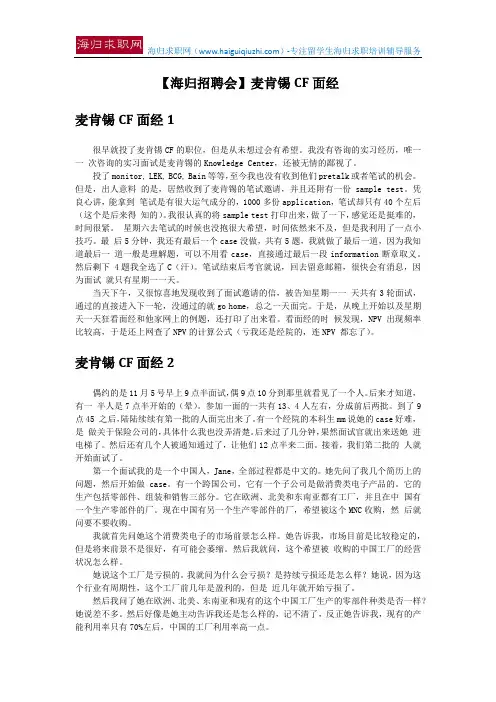
【海归招聘会】麦肯锡CF面经麦肯锡CF面经1很早就投了麦肯锡CF的职位,但是从未想过会有希望。
我没有咨询的实习经历,唯一一次咨询的实习面试是麦肯锡的Knowledge Center,还被无情的鄙视了。
投了monitor, LEK, BCG, Bain等等,至今我也没有收到他们pretalk或者笔试的机会。
但是,出人意料的是,居然收到了麦肯锡的笔试邀请,并且还附有一份sample test。
凭良心讲,能拿到笔试是有很大运气成分的,1000多份application,笔试却只有40个左后(这个是后来得知的)。
我很认真的将sample test打印出来,做了一下,感觉还是挺难的,时间很紧。
星期六去笔试的时候也没抱很大希望,时间依然来不及,但是我利用了一点小技巧。
最后5分钟,我还有最后一个case没做,共有5题,我就做了最后一道,因为我知道最后一道一般是理解题,可以不用看case,直接通过最后一段information断章取义。
然后剩下 4题我全选了C(汗)。
笔试结束后考官就说,回去留意邮箱,很快会有消息,因为面试就只有星期一一天。
当天下午,又很惊喜地发现收到了面试邀请的信,被告知星期一一天共有3轮面试,通过的直接进入下一轮,没通过的就go home,总之一天面完。
于是,从晚上开始以及星期天一天狂看面经和他家网上的例题,还打印了出来看。
看面经的时候发现,NPV出现频率比较高,于是还上网查了NPV的计算公式(亏我还是经院的,连NPV 都忘了)。
麦肯锡CF面经2偶约的是11月5号早上9点半面试,偶9点10分到那里就看见了一个人。
后来才知道,有一半人是7点半开始的(晕)。
参加一面的一共有13、4人左右,分成前后两批。
到了9点45 之后,陆陆续续有第一批的人面完出来了。
有一个经院的本科生mm说她的case好难,是做关于保险公司的,具体什么我也没弄清楚。
后来过了几分钟,果然面试官就出来送她进电梯了。
然后还有几个人被通知通过了,让他们12点半来二面。

麦肯锡面试全过程下面介绍一下全部申请过程:1。
提交简历2。
电话面试3。
飞往总部和其他申请人以及面试官见面,大家吃顿晚饭,聊天。
4。
第二天上午进行一轮笔试,两轮面试。
结束后大家吃午饭。
5。
下午两点,每个申请人被一个面试官带入一间房间,对上午的考核结果进行通知,详细对你的笔试和面试进行分析,告诉你应该在哪些方面加强。
假如考核通过,将继续另外两轮面试,不通过,就预订好出租车,送你回机场。
6。
下午的两轮面试之后,送你回机场,结果第二天或者隔几天告诉你。
7。
通过之后,将会过两个星期再去总部进行最后的面试,也就是商量什么时候上班,薪水多少。
因为我的特殊原因,改在昨天在上海进行最后面试,上班和薪水的事情等我回欧洲再商量。
申请的第一步是提交简历,提交之后Mckinsey回复得很慢,端足了大牌的架子,直到一个星期后才丢过来很是狐疑的一句:你GPA多少?硕士以及本科的成绩单能否给我们看看?真牛,连家底都要翻来审查。
幸好北大的成绩在网站上放着,在国外也能查,马上复制过来,加上现在的成绩一并发过去,心里还不断打鼓,不知该不该将什么马哲毛概留着,免得对方看了之后惊惧万分,以为我们还是红色小将。
又过一星期,估计审查简历的女士高傲的点了点头,扔来一封信,好啦,简历通过,一个月后来总部面试吧,准备签证。
我大喜,就算面试不过,也算公款旅游了,于是乐颠颠的准备签证,在那位清华师兄指点下开始进行案例的学习,真是其乐融融。
哪知风云突变,就在我签证的前一天晚上,对方一个电话过来,歉意地说:“不好意思,面试官病倒了,面试只能推迟,我们决定先派一个人对你电话面试一次”。
我在电话这边脸色立马一灰,嘴上笑嘻嘻的说“不要紧,祝他身体早日康复”,脚下已经一软,差点瘫倒。
之后士气值立马跌落,跟国奥队被马来西亚逼平有的一拼,每晚看案例也是无精打采,翻翻Mckinsey的网站上的案例,我大概能打三十分,估计第一轮面试都过不了,于是更是中心摇摇,不可自持,看着看着就打起了呼噜。
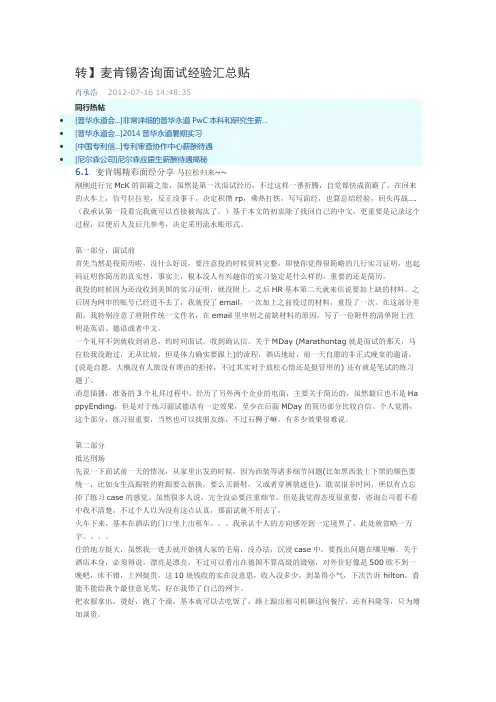
转】麦肯锡咨询面试经验汇总贴肖承浩 2012-07-16 14:48:35同行热帖•[普华永道会...]非常详细的普华永道PwC本科和研究生薪...•[普华永道会...]2014普华永道暑期实习•[中国专利信...]专利审查协作中心薪酬待遇•[尼尔森公司]尼尔森应届生薪酬待遇揭秘6.1 麦肯锡精彩面经分享马拉松归来~~刚刚进行完McK的面霸之旅,虽然是第一次面试经历,不过这样一番折腾,自觉都快成面霸了。
在回来的火车上,信号拉拉差,反正没事干,决定积攒 rp,乘热打铁,写写面经,也算总结经验,回头再战….(我承认第一段看完我就可以直接被淘汰了。
)基于本文的初衷除了找回自己的中文,更重要是记录这个过程,以便后人及后几参考,决定采用流水账形式。
第一部分,面试前首先当然是投简历啦,没什么好说,要注意投的时候资料完整,即使你觉得很简略的几行实习证明,也起码证明你简历的真实性,事实上,根本没人有兴趣你的实习鉴定是什么样的,重要的还是简历。
我投的时候因为还没收到美国的实习证明,就没附上,之后HR基本第二天就来信说要加上缺的材料。
之后因为网申的账号已经进不去了,我就投了email,一次加上之前投过的材料,重投了一次。
在这部分里面,我特别注意了将附件统一文件名,在email里申明之前缺材料的原因,写了一份附件的清单附上注明是英语、德语或者中文。
一个礼拜不到就收到消息,约时间面试。
收到确认信,关于MDay (Marathontag就是面试的那天,马拉松我没跑过,无从比较,但是体力确实要跟上)的流程,酒店地址,前一天自愿的非正式晚宴的邀请,(说是自愿,大概没有人敢没有理由的拒掉,不过其实对于放松心情还是挺管用的) 还有就是笔试的练习题了。
消息插播,准备的3个礼拜过程中,经历了另外两个企业的电面,主要关于简历的,虽然最后也不是Ha ppyEnding,但是对于练习面试德语有一定效果,至少在后面MDay的简历部分比较自信。
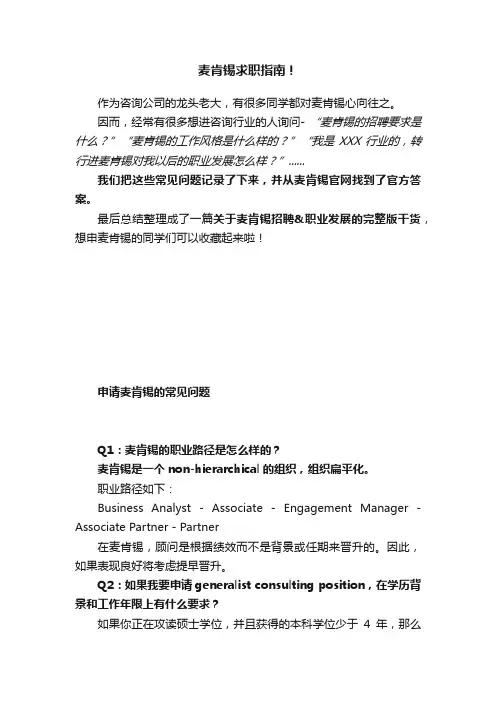
麦肯锡求职指南!作为咨询公司的龙头老大,有很多同学都对麦肯锡心向往之。
因而,经常有很多想进咨询行业的人询问- “麦肯锡的招聘要求是什么?”“麦肯锡的工作风格是什么样的?”“我是XXX行业的,转行进麦肯锡对我以后的职业发展怎么样?”......我们把这些常见问题记录了下来,并从麦肯锡官网找到了官方答案。
最后总结整理成了一篇关于麦肯锡招聘&职业发展的完整版干货,想申麦肯锡的同学们可以收藏起来啦!申请麦肯锡的常见问题Q1:麦肯锡的职业路径是怎么样的?麦肯锡是一个non-hierarchical的组织,组织扁平化。
职业路径如下:Business Analyst - Associate - Engagement Manager - Associate Partner - Partner在麦肯锡,顾问是根据绩效而不是背景或任期来晋升的。
因此,如果表现良好将考虑提早晋升。
Q2:如果我要申请generalist consulting position,在学历背景和工作年限上有什么要求?如果你正在攻读硕士学位,并且获得的本科学位少于4年,那么你将被考虑担任business analyst的职位。
如果你拥有学士学位并且具有至少4年的工作经验,或者你在获得学士学位后的4年内已经完成或希望完成硕士课程,那么你将考虑作为associate加入。
Q3:一定要有商业背景才能进入麦肯锡吗?无需具备商业背景即可尝试申请麦肯锡。
麦肯锡顾问中有超过三分之一的人没有business degree,约有一半的人不是MBA.Q4:通过校招进入麦肯锡有什么需要知道的?•如果我有兴趣申请特定的麦肯锡业务,是否有单独的申请流程:不,只有generalist或者practice preferences的申请。
提交申请时,你可以选择列出最多四个办公室惯例首选项。
•如果我申请暑期实习但未被选中,还能在麦肯锡申请全职职位吗:可以。
如果对实习生对麦肯锡的全职工作感兴趣,麦肯锡希望在秋招收到所有实习生的来信。
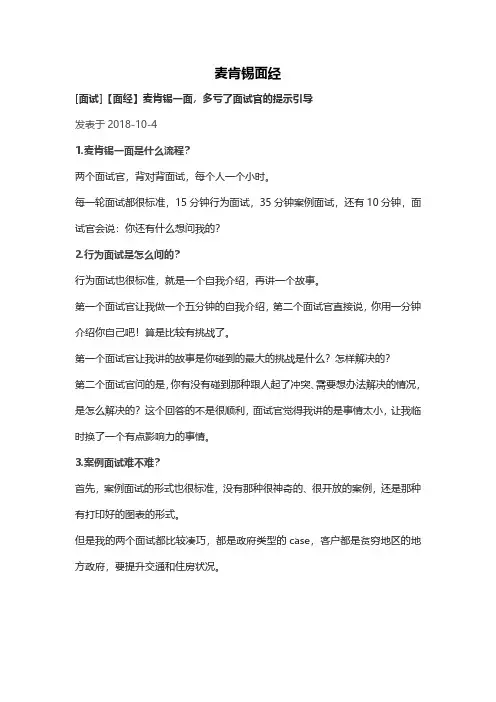
麦肯锡面经[面试]【面经】麦肯锡一面,多亏了面试官的提示引导发表于2018-10-41.麦肯锡一面是什么流程?两个面试官,背对背面试,每个人一个小时。
每一轮面试都很标准,15分钟行为面试,35分钟案例面试,还有10分钟,面试官会说:你还有什么想问我的?2.行为面试是怎么问的?行为面试也很标准,就是一个自我介绍,再讲一个故事。
第一个面试官让我做一个五分钟的自我介绍,第二个面试官直接说,你用一分钟介绍你自己吧!算是比较有挑战了。
第一个面试官让我讲的故事是你碰到的最大的挑战是什么?怎样解决的?第二个面试官问的是,你有没有碰到那种跟人起了冲突、需要想办法解决的情况,是怎么解决的?这个回答的不是很顺利,面试官觉得我讲的是事情太小,让我临时换了一个有点影响力的事情。
3.案例面试难不难?首先,案例面试的形式也很标准,没有那种很神奇的、很开放的案例,还是那种有打印好的图表的形式。
但是我的两个面试都比较凑巧,都是政府类型的case,客户都是贫穷地区的地方政府,要提升交通和住房状况。
做题的顺序也很标准,第一题就是框架,基本上我讲完之后都会问我还有没有什么需要补充的,然后问,那你觉得从哪里开始?然后就到图表分析了。
我觉得第一题讨论结束大概就有10分钟了。
我的两个case都有很多图表,第一个case里面是以图表分析为主,要我从里面找出结论。
我其实没有做好!一个图表通常可以从横向和纵向两个维度去分析,但是我当时漏掉了纵向的分析,所以就少了一个结论。
于是面试官就用比较挑战的方式不断地问我问题,我至少花了五分钟才明白他想引导我去做的是什么分析,然后赶紧做完这个结论才往下走。
第二个case也有很多图表,但是以计算为主的。
因为一共涉及四个图表,很多数字,光是梳理和讲清楚计算的思路就花了三分钟。
其实计算这里,我也犯了一个错误。
我在计算完之后就开始讲,我觉得这个结果还可以通过几个方式进一步改善。
面试官立刻挑战我,也算是提醒我,说你现在已经开始给建议了吗?我们现在还没到时候,你现在只需要回头看看这些数据,告诉我你有什么发现就好了。
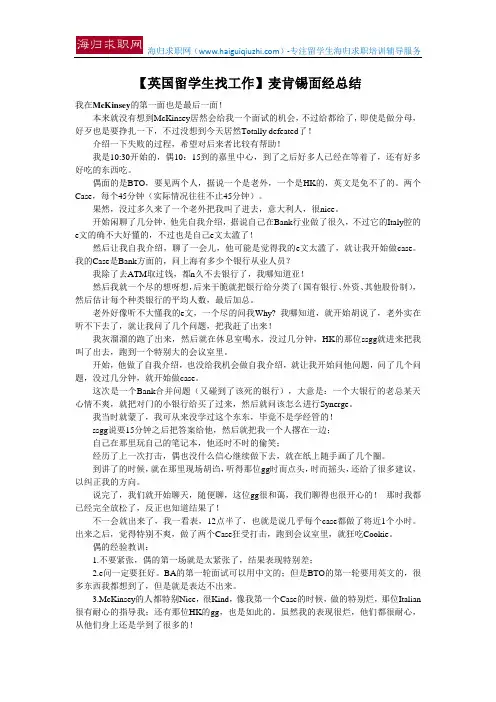
【英国留学生找工作】麦肯锡面经总结我在McKinsey的第一面也是最后一面!本来就没有想到McKinsey居然会给我一个面试的机会,不过给都给了,即使是做分母,好歹也是要挣扎一下,不过没想到今天居然Totally defeated了!介绍一下失败的过程,希望对后来者比较有帮助!我是10:30开始的,偶10:15到的嘉里中心,到了之后好多人已经在等着了,还有好多好吃的东西吃。
偶面的是BTO,要见两个人,据说一个是老外,一个是HK的,英文是免不了的。
两个Case,每个45分钟(实际情况往往不止45分钟)。
果然,没过多久来了一个老外把我叫了进去,意大利人,很nice。
开始闲聊了几分钟,他先自我介绍,据说自己在Bank行业做了很久,不过它的Italy腔的e文的确不大好懂的,不过也是自己e文太滥了!然后让我自我介绍,聊了一会儿,他可能是觉得我的e文太滥了,就让我开始做case。
我的Case是Bank方面的,问上海有多少个银行从业人员?我除了去ATM取过钱,都n久不去银行了,我哪知道亚!然后我就一个尽的想呀想,后来干脆就把银行给分类了(国有银行、外资、其他股份制),然后估计每个种类银行的平均人数,最后加总。
老外好像听不大懂我的e文,一个尽的问我Why? 我哪知道,就开始胡说了,老外实在听不下去了,就让我问了几个问题,把我赶了出来!我灰溜溜的跑了出来,然后就在休息室喝水,没过几分钟,HK的那位ssgg就进来把我叫了出去,跑到一个特别大的会议室里。
开始,他做了自我介绍,也没给我机会做自我介绍,就让我开始问他问题,问了几个问题,没过几分钟,就开始做case。
这次是一个Bank合并问题(又碰到了该死的银行),大意是:一个大银行的老总某天心情不爽,就把对门的小银行给买了过来,然后就问该怎么进行Synerge。
我当时就蒙了,我可从来没学过这个东东,毕竟不是学经管的!ssgg说要15分钟之后把答案给他,然后就把我一个人撂在一边;自己在那里玩自己的笔记本,他还时不时的偷笑;经历了上一次打击,偶也没什么信心继续做下去,就在纸上随手画了几个圈。
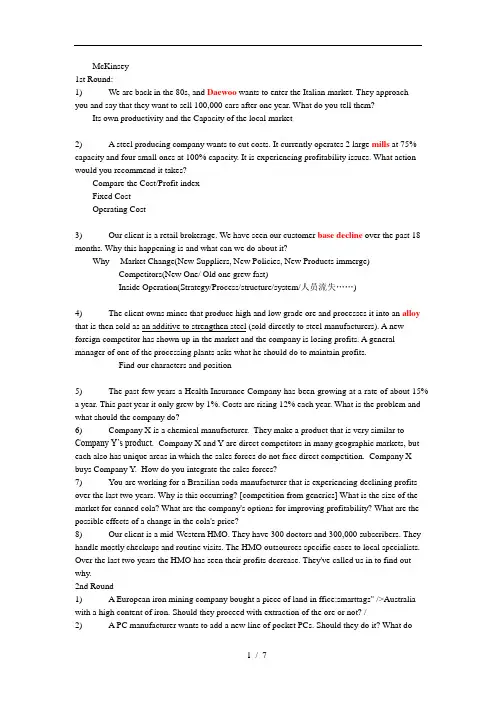
McKinsey1st Round:1) We are back in the 80s, and Daewoo wants to enter the Italian market. They approachyou and say that they want to sell 100,000 cars after one year. What do you tell them?Its own productivity and the Capacity of the local market2) A steel producing company wants to cut costs. It currently operates 2 large mills at 75% capacity and four small ones at 100% capacity. It is experiencing profitability issues. What action would you recommend it takes?Compare the Cost/Profit index---Fixed Cost---Operating Cost---3) Our client is a retail brokerage. We have seen our customer base decline over the past 18 months. Why this happening is and what can we do about it?Why--- Market Change(New Suppliers, New Policies, New Products immerge)Competitors(New One/ Old one grew fast)Inside Operation(Strategy/Process/structure/system/人员流失……)4) The client owns mines that produce high and low grade ore and processes it into an alloy that is then sold as an additive to strengthen steel (sold directly to steel manufacturers). A new foreign competitor has shown up in the market and the company is losing profits. A general manager of one of the processing plants asks what he should do to maintain profits.Find our characters and position5) The past few years a Health Insurance Company has been growing at a rate of about 15%a year. This past year it only grew by 1%. Costs are rising 12% each year. What is the problem and what should the company do?6) Company X is a chemical manufacturer. They make a product that is very similar to Company Y’s product. Company X and Y are direct competitors in many geographic markets, but each also has unique areas in which the sales forces do not face direct competition. Company X buys Company Y. How do you integrate the sales forces?7) You are working for a Brazilian soda manufacturer that is experiencing declining profits over the last two years. Why is this occurring? [competition from generics] What is the size of the market for canned cola? What are the company's options for improving profitability? What are the possible effects of a change in the cola's price?8) Our client is a mid-Western HMO. They have 300 doctors and 300,000 subscribers. They handle mostly checkups and routine visits. The HMO outsources specific cases to local specialists. Over the last two years the HMO has seen their profits decrease. They've called us in to find out why.2nd Round1) A European iron mining company bought a piece of land in ffice:smarttags" />Australia with a high content of iron. Should they proceed with extraction of the ore or not? /2) A PC manufacturer wants to add a new line of pocket PCs. Should they do it? What doyou tell the CEO?3) A health and fitness center, a chain of gyms, like Bally's is considering building more tennis courts. The cost of the land development isgh occupancy rates averaged 80 percent. - charts given3) a music company is bringing out a cd for a new artist. how would you market and price, knowing that you''d like to charge a premium for the cd?final round (nov. 2002)1) you are consulting to the manufacturer of airplane engines (2 main engines: for wide body planes and narrow body planes ——> regional and low cost airlines, which are growing, use the narrow body planes). the client is considering entering the airplane leasing market, because one of its competitors (ge) is already there, and the client hypothesizes that ge''s presence in leasing helps its engine sales. what do you tell him?2) last year, lawsuits cost corporations $200 billion compared with $70 billion in 1990. how would you advise a roundtable of ceos to attack tort reform?3) the u.s. post office lost millions last year. how would you advise the new ceo to turn the post office around?4) we have been hired by a mexican company that has a dominant position in all of its markets but one: ketchup. although its ketchup sales have been increasing, its market share is stagnant (10%) and its profit margin remains below that of its competitors. what do you think might be happening? what would you suggest the client do in order to increase market share and profits?a small pharmaceutical research company is about to start clinical trials for a new and promising molecule. the trial process has three phases, with different associated costs and probabilities of success:costs (million) pr. success- phase 1 $10 .40- phase 2 $5 .2- phase 3 $80 .105if the process is successful and the new drug is introduced in the market, it would generate total income flows of $300 million.+ draw a graph showing the income stream for the next ten years (assume that full adoption is reached in year 7)+ the pharmaceutical company is looking for a buyer. how much should it ask for?booz1st round1) our client is a magazine publisher. they are considering a new pricing program where the price for subscriptions would increase every year. evaluate how such a decision would impact their business. would you advise they do it?bain1st round (nov. 2003)1) our client is apple publishing, the largest publisher of children’s fiction in the industry. seven years ago the ceo became concerned that childhood literacy rates were low and decided to make a difference. he entered the telemetry textbook market. he thinks they are the best now, but hasn’t been rewarded. seven years later he has 70 million dollars in sales and 20 million dollars inlosses. they are less than 5% of the market, but the ceo wants to stay in the market, how can he do it?2) our client produces 2-inch wrenches. they sell to home depot and also toauto-mechanics directly. if you were a store manager at home depot, how many varieties of wrenches would you display to sell and at what price points? how are the home depot wrench buyers different from the auto mechanics? if you wanted to provide discounts to the auto mechanics, which of them would you target and why? what information would you want from them first?3) university town has a population of 40,000 students. currently there are nine restaurants. you''re client is thinking about opening up the tenth. is this a good idea and should she open up a fast food or a specialty restaurant?4) a major airline is thinking about going head to head with the discount airlines by offering "cheap" fares. does this make sense? estimate the size of the european "discount" airline market.5) your client sells coffee on the five japanese bullet trains (high speed trains). estimate the size of the market. how would you advise them to increase sales?6) our client, a private equity firm, is considering an investment in a manufacturer of digital inkjet printers (printing large billboards). the manufacturer wants to enter the screen printing market (printing signs and point-of purchase posters, e.g. for supermarket sales). how big is the screen printing market? which particular segment is the most attractive?7) estimate the market size of printers in hong kong. a u.s.-based pc manufacturer now wants to get into the printer market. assess the opportunity.8) we have been hired by a global wealth management company that has 2 divisions: asset management and private banking. our asset management profits have been decreasing, and our private banking profits have been increasing. we need to help our client determine strategy to increase all his profits.9) we have been hired by the board of a company that is loosing money. the board has asked us to determine whether any of this loss can be attributed to the leer jet that the management team uses.10) we have been hired by a company that has just finished making the millennium eye,a large ferris wheel that will be placed in the middle of london. our client wants to know how big the market is and how much we should charge per ticket.a.t. kearney1st round (oct. 2003)1) the cfo of a top 3 retailer wants you to evaluate the viability of developing exclusive contracts with distributors. the three questions you should address are:1. pro''s and con''s of pursuing exclusive contracts2. identify the categories that should be explored for exclusive contracts3. how would you operationalize these contracts?2) case setup (facts offered by interviewer):your client is a u.s. basedq oil refinery. the refinery has a single location and is a small to medium-sized refinery. your client, although profitable, believes it is lagging behind the competition and could improve. you are brought in as part of a joint consultant-client team that will review overall operations and make recommendations on ways to improve the bottom line.you have been assigned to work with the maintenance division. the maintenance depa rtment’s primary objective is to prevent equipment failure and to repair equipment when it does fail. understanding of its organization is important. it consists of three primary areas: nine assets areas, one central maintenance area and one group of contractors. the first two areas are employees of the client, the third an external source of labor. an asset is a physical area of the plant that contains various pieces of equipment (pumps, heat exchangers, etc.). there are nine assets. each asset has a maintenance supervisor who is responsible for all maintenance to be performed in his/her asset. working for the maintenance supervisor in each asset is, on average, eleven “craftsmen”. the craftsmen are the actual workers that perform the maintenance. the craftsmen are unionized and divide into twelve different craft designations (e.g. electricians, pipefitters, welders, etc.). each craft designation has a defined set of skills they are qualified to perform. they are not allowed to perform skills outside of their defined craft, or help in the performance of activities involving skills beyond their craft. collectively the twelve different crafts can perform any maintenance job that might arise at the refinery. the maintenance supervisor and his/her assigned craftsmen are “hardwired” to their asset. that is, they work only on equipment in their given asset.central maintenance is a centralized pool of maintenance supervisors and craftsmen, who are dispatched to support the different assets during times of high workload. they are employees of your client and fit the description contained in the above asset explanation. the only difference is that they may work in any of the different assets as determined by workload. there are a total of 11 maintenance supervisors and 100 craftsmen that comprise central maintenancecontractors are a group of outside supervisors and craftsmen who support your client during times of high workload. they also are capable of performing any maintenance job that may arise, but differ f rom your client’s craftsmen in that they divide the collective skills required into five designations rather than twelve. thus, the craftsmen of the contractor are capable of performing a broader set of skills. they, like your client’s craftsmen, don’t per form skills outside of their defined craft but do allow different craft designations to help each other. there are an average of 7 contractor maintenance supervisors and 140 contractor craftsmen at the refinery on any given day.question:whatq opportunities exist to increase profits?what recommendations can you make to capture savings related to the identified opportunities? what is the cost savings associated with your recommendations?suggested solutions:the first question involves identifying opportunities to improve profits. the candidate must start with either revenues or costs. although one could make the argument that maintenance supports revenue by maximizing the operating time of the refinery equipment, maintenance should be seen to be a support function. thus, it is more appropriate to focus on costs and cost reduction. the following questions will help the candidate gain insight into cost reduction opportunities.how does the maintenance department track its costs?if the candidate phrases the question about material or overhead costs, the interviewer would inform the candidate that detailed reviewed showed no major opportunities. the candidate would be steered toward labor costs and given the following tables regarding maintenance labor costs forthe past year.to support understanding of the following tables, turnaround work is long term preventive maintenance (e.g. complete rebuilding of a boiler) that may be performed once every few years. all other work (short term emergency repairs, small scale preventive maintenance, other routine work, etc.) fits into the category of daily workcraftsmen daily work turnaround totalclient $ 8mm $ 2mm $ 10mmcontractor $ 5mm $ 9mm $ 14mmtotal $ 13mm $ 11mm $ 24mmsupervisor totalclient $ 1mmcontractor $ 0.5mmtotal $ 1.5mmsince the craftsmen table represents a larger dollar amount than the supervisor table, it is logical to pursue cost savings opportunities in this area first.what is the utilization of craftsmen in the assets?in central maintenance?and for contractors?assume each area is utilized 100% of the time, 50 weeks per year, 40 hours per week.how does the labor cost of craftsmen ($24mm) on a refinery-sized basis (i.e., $cost / per barrel of crude oil processed) compare with industry averages?consulting your industry data base shows that costs appear to be about 20% above the average of peer refineries.this is an important question to determine if there is a problem with costs (don’t assume there is, the client may be performing better than industry average!)is there any particular reason why turnaround work is so heavily skewed toward contractors? turnaround work tends to be more cyclical. an external workforce is used to absorb some of this additional work. keep in mind that both client and contractor craftsmen are capable of performing any maintenance job at the plant.after further analysis of the tables the key fact that should become appear odd is the large difference in the cost per unit of labor between your client’s craftsmen and the outside contractor’s craftsmen. often candidates will ask for the hourly wage rates of these two groups. there is sufficient data to calculate these numbers. the calculation is:annual cost of client craftsmen = $10mm/ (11 craftsmen/asset x 9 assets + 100 craftsmen in central maintenance) = $50,000 / yearannual cost of contractor craftsmen = $ 14 mm/ 140 contractor craftsmen = $100,000 / year again, this difference should provoke a series of questions to understand the difference.is there any difference in the work performed by the client and contractor craftsmen?no, other than the different levels of turnaround work vs. daily work performed as noted in the previous table. both groups are capable of doing any job with roughly equal levels of quality.is there any difference in efficiency between the two groups of craftsmen?the candidate would at this point be asked how they would measure this.after reaching an understanding of the difficulty involved in measuring the efficiency of aworkforce (especially a unionized workforce), the candidate would be told that through a series of interviews with maintenance supervisors, there is a consensus that contractor craftsmen are roughly twice as productive as client craftsmen.this is a critical point in the case. the candidate must recognize that in the present environment the client is largely indifferent about units of labor. you can have a client worker who is half as efficient or a contractor worker who is twice as expensive. the key now is to determine if there are ways to create an opportunity where the client would no longer be indifferent.what is cau sing the inefficiencies associated with the client’s labor?again, the candidate would be encouraged to offer their own ideas.after some discussion the candidate would be told that many of the maintenance supervisors complain endlessly about restrictions placed on them by the existing union labor contract and the tightness of craft designations.the interviewer would probe to ensure the candidate understands why the present craft designation creates the inefficiencies. essentially work is too finely divided. it makes planning and supervision extremely cumbersome. as an example, if one of six crafts required to perform a job is absent or late, the entire job must shut down, as craft designations are not allowed to support other craft designations.is it possible to change the existing union contract?the present labor contract is a three year contract that is due to be renegotiated/renewed in six months.will the union resist changes to the existing contract?indeed!!at this point, the candidate should recognize a major (albeit difficult) opportunity to reduce labor costs. the client would essentially like to have its own employees look and function like its contractors, but continue to get paid at present rates. in reality, management will need to make wage concessions in order to change present work practices. however, through planned negotiations a scenario can be created which presents a favorable opportunity for your client to begin to replace outside contractors with its own craftsmen.there are several ways to address the third question of the case, the actual savings that might be achieved. one quick method is to assume that these changes would bring maintenance costs back in line with industry average. utilizing the cost benchmark mentioned earlier, one could assume costs could be reduced to $24mm/1.20 = $20mm, a $4mm savings.a second, and more detailed, method would be to take the extreme scenario where the client’s craftsmen is paid its present rate, but is made as efficient as the contr actor’s craftsmen. in this case, you begin with the present level of 200 client craftsmen who are functioning as 100 equivalent contractor craftsmen (they’re one-half as efficient). by improving their efficiency, you are effectively “creating” 100 equivale nt contractors. thus, you are immediately able to replace 100 contractors and save $10mm. this could be taken one step further by assuming you would want to replace all contractors. this would save an additional $2.5mm ($4mm existing contractor expense - $2mm required to hire additional client craftsmen + $0.5mm in contractor supervisors). as noted earlier, in reality, this approach would require wage concessions to the union, so actual savings may be something significantly less.key takeaways:this case requires the candidate to quickly digest a large amount of organizational issues and then quickly check some ratios to uncover the basic problem (the client workforce is inefficient). creativity must then be used to structure a recommendation that would create a more favorable situation for the client. as in other cases, acceptable solutions need not follow the exact method above nor cover all of the above points.mercer1st round1) a new england telephone company is thinking of entering the home security market. what is the potential market size and what would you recommend they do?2) if i gave you $10 million dollars to invest in any one business, which would it be?3) should kraft foods expand and incorporate ice cream into their product mix? if yes, how should they enter this market?4) you are starting a new business, a gourmet coffee shop. the shop is located next to a train station. you''re building the business with the hope of selling it within two years. what is your strategy?5) how big is the market for window display marketing books?2nd round(nov 2004):we have been hired by a client to help her evaluate his product mix and determine the best one going forward. refer to graphs.。
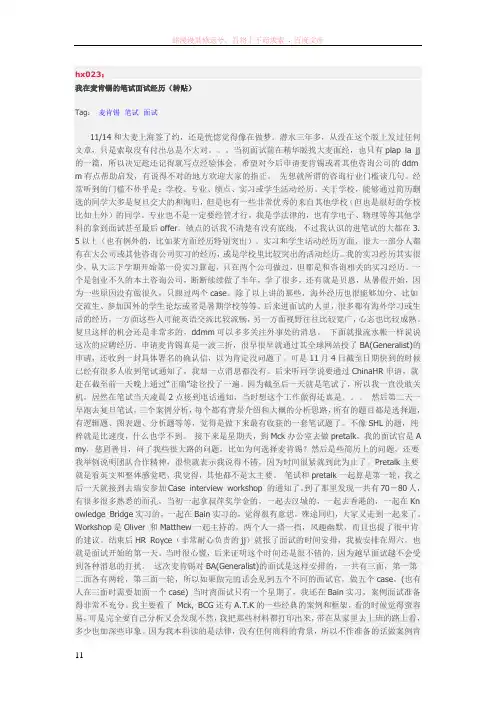
hx023:我在麦肯锡的笔试面试经历(转贴)Tag:麦肯锡笔试面试11/14和大麦上海签了约,还是恍惚觉得像在做梦。
潜水三年多,从没在这个版上发过任何文章,只是索取没有付出总是不大对。
当初面试前在精华版找大麦面经,也只有plap la jj 的一篇,所以决定趁还记得就写点经验体会,希望对今后申请麦肯锡或者其他咨询公司的ddm m有点帮助启发,有说得不对的地方欢迎大家的指正。
先想就所谓的咨询行业门槛谈几句。
经常听到的门槛不外乎是:学校、专业、绩点、实习或学生活动经历。
关于学校,能够通过简历删选的同学大多是复旦交大的和海归,但是也有一些非常优秀的来自其他学校(但也是很好的学校比如上外)的同学。
专业也不是一定要经管才行,我是学法律的,也有学电子、物理等等其他学科的拿到面试甚至最后offer。
绩点的话我不清楚有没有底线,不过我认识的进笔试的大都在3. 5以上(也有例外的,比如某方面经历特别突出)。
实习和学生活动经历方面,很大一部分人都有在大公司或其他咨询公司实习的经历,或是学校里比较突出的活动经历。
我的实习经历其实很少,从大三下学期开始第一份实习算起,只在两个公司做过,但都是和咨询相关的实习经历。
一个是创业不久的本土咨询公司,断断续续做了半年,学了很多,还有就是贝恩,从暑假开始,因为一些原因没有做很久,只跟过两个case。
除了以上讲的那些,海外经历也很能够加分,比如交流生、参加国外的学生论坛或者是暑期学校等等。
后来进面试的人里,很多都有海外学习或生活的经历,一方面这些人可能英语交流比较流畅,另一方面视野往往比较宽广,心态也比较成熟。
复旦这样的机会还是非常多的,ddmm可以多多关注外事处的消息。
下面就报流水帐一样说说这次的应聘经历。
申请麦肯锡真是一波三折,很早很早就通过其全球网站投了BA(Generalist)的申请,还收到一封具体署名的确认信,以为肯定没问题了。
可是11月4日截至日期快到的时候已经有很多人收到笔试通知了,我却一点消息都没有。
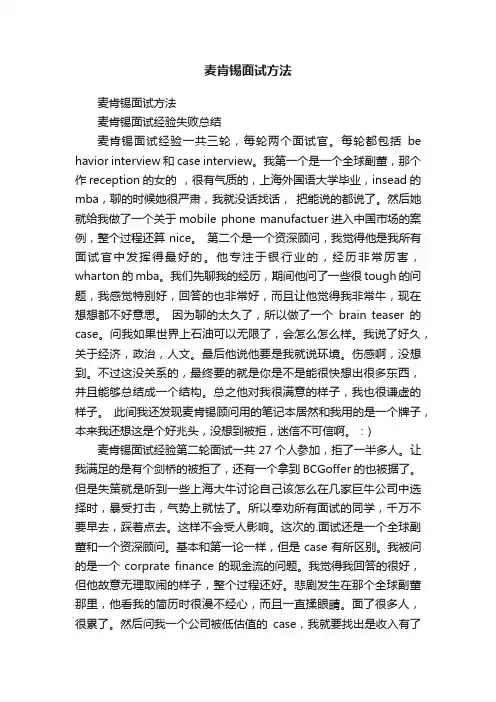
麦肯锡面试方法麦肯锡面试方法麦肯锡面试经验失败总结麦肯锡面试经验一共三轮,每轮两个面试官。
每轮都包括be havior interview和case interview。
我第一个是一个全球副董,那个作reception的女的,很有气质的,上海外国语大学毕业,insead的mba,聊的时候她很严肃,我就没话找话,把能说的都说了。
然后她就给我做了一个关于mobile phone manufactuer进入中国市场的案例,整个过程还算nice。
第二个是一个资深顾问,我觉得他是我所有面试官中发挥得最好的。
他专注于银行业的,经历非常厉害,wharton的mba。
我们先聊我的经历,期间他问了一些很tough的问题,我感觉特别好,回答的也非常好,而且让他觉得我非常牛,现在想想都不好意思。
因为聊的太久了,所以做了一个brain teaser的case。
问我如果世界上石油可以无限了,会怎么怎么样。
我说了好久,关于经济,政治,人文。
最后他说他要是我就说环境。
伤感啊,没想到。
不过这没关系的,最终要的就是你是不是能很快想出很多东西,并且能够总结成一个结构。
总之他对我很满意的样子,我也很谦虚的样子。
此间我还发现麦肯锡顾问用的笔记本居然和我用的是一个牌子,本来我还想这是个好兆头,没想到被拒,迷信不可信啊。
:) 麦肯锡面试经验第二轮面试一共27个人参加,拒了一半多人。
让我满足的是有个剑桥的被拒了,还有一个拿到BCGoffer的也被据了。
但是失策就是听到一些上海大牛讨论自己该怎么在几家巨牛公司中选择时,暴受打击,气势上就怯了。
所以奉劝所有面试的同学,千万不要早去,踩着点去。
这样不会受人影响。
这次的.面试还是一个全球副董和一个资深顾问。
基本和第一论一样,但是case有所区别。
我被问的是一个corprate finance的现金流的问题。
我觉得我回答的很好,但他故意无理取闹的样子,整个过程还好。
悲剧发生在那个全球副董那里,他看我的简历时很漫不经心,而且一直揉眼睛。
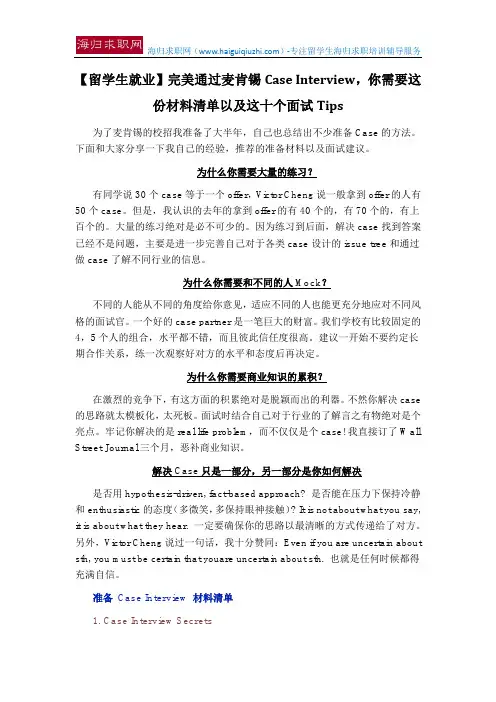
【留学生就业】完美通过麦肯锡Case Interview,你需要这份材料清单以及这十个面试Tips为了麦肯锡的校招我准备了大半年,自己也总结出不少准备Case的方法。
下面和大家分享一下我自己的经验,推荐的准备材料以及面试建议。
为什么你需要大量的练习?有同学说30个case等于一个offer,Victor Cheng说一般拿到offer的人有50个case。
但是,我认识的去年的拿到offer的有40个的,有70个的,有上百个的。
大量的练习绝对是必不可少的。
因为练习到后面,解决case找到答案已经不是问题,主要是进一步完善自己对于各类case设计的issue tree和通过做case了解不同行业的信息。
为什么你需要和不同的人Mock?不同的人能从不同的角度给你意见,适应不同的人也能更充分地应对不同风格的面试官。
一个好的case partner是一笔巨大的财富。
我们学校有比较固定的4,5个人的组合,水平都不错,而且彼此信任度很高。
建议一开始不要约定长期合作关系,练一次观察好对方的水平和态度后再决定。
为什么你需要商业知识的累积?在激烈的竞争下,有这方面的积累绝对是脱颖而出的利器。
不然你解决case 的思路就太模板化,太死板。
面试时结合自己对于行业的了解言之有物绝对是个亮点。
牢记你解决的是real life problem,而不仅仅是个case! 我直接订了Wall Street Journal三个月,恶补商业知识。
解决Case只是一部分,另一部分是你如何解决是否用hypothesis-driven, fact-based approach? 是否能在压力下保持冷静和enthusiastic的态度(多微笑,多保持眼神接触)? It is not about what you say, it is about what they hear. 一定要确保你的思路以最清晰的方式传递给了对方。
另外,Victor Cheng说过一句话,我十分赞同:Even if you are uncertain about sth, you must be certain that youare uncertain about sth. 也就是任何时候都得充满自信。
麦肯锡面试题在面试过程中,麦肯锡公司通常会提出一系列挑战性的问题,以评估应聘者的思维能力、沟通技巧和解决问题的能力。
以下是一道麦肯锡面试题的概述,以便应聘者可以更好地准备面试。
问题描述假设你是一家麦肯锡咨询公司的高级顾问。
最近,你的团队收到了一份任务:为一家跨国电子零件制造商制定一个新的全球战略。
该公司面临着竞争日益激烈的市场环境,并希望找到一种创新的方法来增加其市场份额并提高收益。
你的任务是设计一种方法,以评估该公司在全球市场中的竞争优势,并提出相关的战略建议。
在解决这个问题之前,请回答以下问题:1. 在制定全球战略时,你认为哪些因素是最重要的?为什么?2. 同行业的其他公司可能具有什么优势?该公司如何应对这些竞争对手?3. 你将如何评估该公司在不同市场的竞争优势?你将使用哪些指标来衡量其绩效?4. 基于你的分析,你将提出哪些战略建议来帮助该公司增加市场份额并提高收益?解决方案问题1:全球战略的重要因素制定全球战略时,有几个关键因素必须考虑。
首先,市场需求与机会分析是至关重要的。
了解不同市场的需求、竞争情况以及潜在机会,可以帮助确定公司的全球战略。
其次,要研究法律和政治环境,了解各国的法规制度和政策对该公司业务的影响。
最后,了解文化差异以及国际贸易和物流等因素,以便在全球范围内进行战略决策。
问题2:竞争对手的优势及对策同行业的其他公司可能通过不同的方式获得竞争优势。
这些竞争优势可能包括技术创新、产品质量、品牌形象、供应链管理等。
该公司可以通过以下方式应对竞争对手:加强研发和创新能力,提高产品质量,改善客户体验,提升品牌形象,优化供应链管理等。
问题3:评估竞争优势的指标评估该公司在不同市场的竞争优势时,可以使用多个指标。
例如,市场份额是一个关键的指标,可以衡量公司在特定市场中的占有率。
此外,销售增长率、市场覆盖范围、客户满意度等也是评估竞争优势的重要指标。
问题4:战略建议基于分析结果,提出以下战略建议以帮助该公司增加市场份额并提高收益:1. 加强研发和创新能力,推出更多具有差异化竞争优势的产品。
麦肯锡面试经验麦肯锡是世界著名的管理咨询公司之一,其综合能力与专业性备受业界认可。
作为一家行业领军企业,麦肯锡对招聘的要求也非常高。
面试是每个应聘者在求职过程中最为重要的部分,因此掌握一些面试经验是必要的。
在这里,我将分享一些麦肯锡面试经验,希望对即将面试或正在面试中的同学有所帮助。
一、面试前准备在准备面试之前,应聘者需要充分了解麦肯锡的企业文化、业务领域以及行业动态,以及整个招聘流程。
此外,建议应聘者自我检查并评估自己的强项和弱项,并准备好自己的故事,以便在面试中能够简单、清楚地介绍自己的背景、专业领域和工作经验。
二、面试环节麦肯锡的面试通常包括个人面试、小组讨论和案例分析等几个环节。
1. 个人面试麦肯锡的个人面试通常持续60分钟左右,涵盖个人情况、工作历程及背景、能力和兴趣等方面。
在个人面试中,应聘者需要展现出自己的智商、情商和能力。
一些常见的问题包括:- 介绍一下自己的职业生涯;- 你认为自己最大的优点是什么;- 描述一个你在工作中取得的成就;- 你最喜欢的领域是什么,或者你最擅长的领域是什么;- 你在职业生涯中遇到过的最大的挑战是什么。
在个人面试中,应聘者需要清楚、明确地回答问题,并且以事实为依据,防止出现虚假言辞。
此外,还需要积极表现出对麦肯锡企业文化和业务领域的了解和认同。
2. 小组讨论小组讨论通常由4-6名面试者组成,持续时间为30-45分钟。
在小组讨论中,应聘者需要充分表现出自己的沟通和表达能力,在团队中起到积极的作用。
小组讨论通常涉及某个问题或主题,要求面试者在给定的时间内讨论解决方案。
建议应聘者在讨论中积极发言,并表现出自己良好的团队合作精神。
3. 案例分析麦肯锡的案例分析通常是面试的重点和难点环节之一。
在案例分析环节中,应聘者需要根据事实数据和现实情况来分析问题,提出可行的解决方案,并进行推销。
麦肯锡的案例通常包含数学、财务、市场、组织、战略等多方面知识,考验面试者的思考和分析能力。
Preparing for your McKinsey interviewThe Interviewer’s PerspectiveCommon Interview QuestionsCase StudiesAsk a QuestionTHE INTERVIEWER’S PERSPECTIVEDuring every stage of your interview process we will be probing your ability to listen,process information, think creatively, and articulate your thoughts. We will assess your strengths against the four major attributes we believe are common to successful McKinsey consultants:•Problem-solving ability•Personal impact•Leadership•Drive/aspirationsProblem-solving abilityWe’ll use case studies and other probative techniques to gauge your intellectual horsepower, logical reasoning ability,curiosity, creativity,business judgment,tolerance for ambiguity,and intuitive feel for numbers.Personal impactYour presence, personality, level of assertiveness, empathy,and communications style are intrinsic to your success as a consultant. We will test your ability to listen as well as to articulate your own point of view—and your ability to stand by your views if challenged。
McKinsey Guidelines for Case Preparation Kellogg students who participate in McKinsey & Company’s Case Interview Workshops are usually asked to bring a prepared case to be used in breakout sessions during the workshop. These guidelines are distributed in advance to aid participants in their case preparation.WHAT IS A CASE INTERVIEW?A case is a description of a real business problem. Case interviews are designed to test problem-solving skills. A case interview typically lasts 20 to 30 minutes and is a verbal exchange between the interviewee and the interviewer. During a case interview, the interviewee asks the interviewer questions to get enough data to recommend a solution; the interviewer provides the information that is asked for and helps the interviewee stay on track to develop an approach. At the end of the interview, the interviewee should be able to recommend a solution to the original problem presented by the interviewer. Understand that the interviewee is not often expected to find a solution to the problem; a logically structured, fact-based recommendation is usually enough. Remember, the case interview is designed to mimic a typical McKinsey client engagement: clients hire McKinsey to make a recommendation about a problem that they are having. The objective of the interviewee is to identify the key issues of the problem, develop potential approaches to making a recommendation, and if possible, hypothesize a solution.HELPFUL GUIDELINES FOR PREPARING YOUR CASEThe following sections provide guidelines developed by McKinsey & Company to assist you during your case preparation.Selecting Your CaseMcKinsey interviewers choose their cases based on past business experiences. When developing your own case, we suggest, if possible, that you do the same. Try to draw on real-world experiences or business problems that you have been exposed to as part of your Kellogg courses. These experiences and problems provide a great foundation for a case. You can also pick an interesting situation being covered in the media (e.g. BusinessWeek, The Wall Street Journal, etc.).Kicking-off Your Case InterviewMost cases start out with a phrase such as “A CEO of a hockey equipment manufacturer has asked McKinsey to... You are the Associate on the team and we need to get back to the CEO with our preliminary answer to his or her question within the next half an hour.”The following questions pose typical problems that you could expect in case interviews. The case you develop for the workshop might involve the solution to a similar question. Keep these types of questions in mind when developing your case content.¶“How should Company X respond to significant environmentalchanges?”¶“What products and to what customer segments should acompany sell?”¶“Should Company X add capacity?”¶“How should Company X react to a new competitor?”¶“Should Company X enter/exit a new/old market?”Case Content & DeliveryAs mentioned earlier, the “meat” of a case is a dialogue between the interviewee and interviewer. The interviewee asks a series of questions to gather data necessary to solve the case. The interviewer will ask probing questions, or redirects the conversation if the interviewee becomes stuck or heads in a wrong direction while approaching the problem.To effectively deliver a case, it is critical that the interviewer has a deep understanding of the facts and background of the case. Thus, most of our interviewers have a background sheet(s) to refer to during the course of the interview. Some interviewers take this one step further and prepare summary charts of the key data the interviewee may need to solve the case.Background sheets should contain all the information that the interviewee will need to logically solve the case. We suggest that you prepare a background sheet for your practice case, but please do not feel obligated to go into great detail. A solid understanding of the problem, the relevant business issues, and possible solutions will be sufficient. Below, we have summarized some major categories of information you might want to compile for your practice cases.Element DescriptionProblem definition Be very clear in the problem that the client hasasked you to solve.Industry Understand what industry the client competes inand what industry we are helping to evaluate (ifdifferent).Competitive environment Understand the environment, including how concentrated the industry is and why it has been growing, shrinking, or staying the same. Understand the relevant changes to the competitive environment including changes in regulation, pressure from new competitors, impact of technology, impact of demographic trends, etc.Customers segments Understand the size, profitability and growth of the key customer segments.Competitors Understand the market share, growth,profitability and strategic starting points of ourleading competitors.Understand what the best players in the industrydo and why this is successful for them (youshould also understand why these strategieswould work or fail for your client).Client’s strategic starting point Understand the client’s distinctive competencies and capabilities.Economics of business decision Have detailed support of the revenues, costs for the company, major business units and customer segments as necessary.Have detailed support of the revenues, costs, capital expenditures and potential NPV of any business strategy alternatives.Understand the breakdown of revenue and costs (e.g. fixed versus variable).This list is by no means exhaustive, but we hope it gives you a good start. If you have difficulty preparing your case, please call Chuck Baren at (312) 551-3909 for guidance.。
麦肯锡初级助理面试经验麦肯锡初级助理面试经验和教训:这里有三种产品,分别是西红柿、豪华车和T恤衫,每一种选择一些则产品适用的增值税是多少?”看在眼里我相信我们每个人心里多少都会有些想法,直觉偏差豪华车最贵是不是要缴纳更多的增值税?这里就有程序化思维,从什么角度去探究。
那么吗适用增值税的增值税是多少呢?资源税这里回到一个问题什么是增值税,增值税有分几种?我的认真思考逻辑是这样的,西红柿,农业加工产品,卖出更多的西红柿可以帮助农业更好的发展,同时健康自然。
豪华车,买得起的人少,产品精致,更加侧重环保细节。
T恤衫,低成本,销量大,工厂生产破坏环境,科技含量低。
那么应该是T恤衫>豪华车>西红柿?我查了点资料,增值税是对销售货物或者提供加工、修理修配劳务以及进口货物实现单位和个人就其的的增值额征收的一个税种。
增值税税率分为五档:基本税率17%、低税率13%、7%、征收率和零税率。
那么我的答案是西红柿13%或者7%,豪华车17%,T恤衫17%。
:终于到了谈面试的部分了!我在这也详细描述一下,有同学说之前简历求职信篇的时候一直在说项目的介绍,而面试官真正看重的是技术啊?我在这做个解释,因为我写的这些文章主要针对的是软件测试的次要同学,所以其他职位的请根据自己的情况来改,比如你是面的下端或者java等,那当然要突出你在编程中恐怕的表现了!首先来说,可以很好的理解和完成前认同三篇介绍的任务,那么你问题所在接到面试电话!然而有的同学在这之前却因为收不到面试对于长期失业或者谋求换工作的人来说,在现在的就业本土市场中获得面试机会,可能将就像胜利了一样。
但是,一旦开始面试,问题面试官常常会用一系列具有迷惑性的问题来考验你,这些问题有着双重或是潜藏的目的。
你知道如何...你提前研究了心仪的各种背景资料,穿上自己老土最时髦得体的衣服,并且为面试精心准备了一番。
你机智缺陷地回答了面试官提出的所有问题,甚至一些奇怪的问题,诸如“如果你是一个pizza外送员,剪刀对你有什么用。
Preparing for your McKinsey interviewThe Interviewer’s PerspectiveCommon Interview QuestionsCase StudiesAsk a QuestionTHE INTERVIEWER'S PERSPECTIVEDuring every stage of your interview process we will be probing your ability to listen, process information, think creatively, and articulate your thoughts. We will assess your strengths against the four major attributes we believe are common to successful McKinsey consultants:•Problem-solving ability•Personal impact•Leadership•Drive/aspirationsProblem-solving abilityWe’ll use case studies and oth er probative techniques to gauge your intellectual horsepower, logical reasoning ability, curiosity, creativity, business judgment, tolerance for ambiguity, and intuitive feel for numbers.Personal impactYour presence, personality, level of assertiveness, empathy, and communications style are intrinsic to your success as a consultant. We will test your ability to listen as well as to articulate your own point of view—and your ability to stand by your views if challenged. We will try to see if you would be comfortable in a team situation, and if you have an interest in other people and a sense of self-confidence without arrogance - in other words, we are looking for people who are fun to work with.LeadershipYour willingness to take on a leadership role is as important at McKinsey as your ability to work as part of a team. We will explore your ability to seize opportunity and take action and ask you to show us how you might build a team and encourage and facilitate a shared vision. We will be looking for signs of entrepreneurship, including a willingness to take a personal risk. We will seek evidence of your persistence in the pursuit of what you want, and your ability to keep a clear focus amidst escalating demands.Drive/aspirationsWe will be assessing your personal drive for excellence, as well as your energy level and perseverance. We will want to know if you set high aspirations for yourself and expect outstanding results. We will assess how you handle obstacles and if you are willing to go outside your comfort zone in order to achieve what you want.COMMON INTERVIEW QUESTIONSDuring your McKinsey interviews we will be probing your strengths along four key areas: problem-solving ability, personal impact, leadership, and drive/aspirations. We will be asking a series of questions designed to help us get to know you better along these lines. Here is a sampling of the type of questions you can expect.•To assess your problem-solving ability•To assess your personal impact•To assess your leadership•To assess your drive/aspirationsProblem-solving ability•How would you go about estimating your competitor's budget for ___________ expenses? What other numbers would you want to know in order to estimate it?•What kinds of things could a ________ business do to become more profitable?Other things such as competitive position being the same, which type of business do you think would have greater returns on sales: _________ or __________?•What could you do to reduce absenteeism in a ______ factory?•Where might you look for information on traffic patterns near a shopping mall?•Describe a situation you handled creatively.•Describe a situation in which you had to convince others that your view, approach, or ideas were right or appropriate.•Describe a tough decision and how you reached it.Personal impact•What experiences have you had working in teams? Using a specific example, what role did you play on the team? How did you select that role? What were the most/least satisfying aspects of working on that team? What is the most difficult thing for you in working with a team?•Describe your relationships with colleagues, professors, bosses, and others in a significant academic/work experience. In what ways were you most effective with people? What conflicts or difficulties did you experience? What kinds of people did you find most challenging? What would your colleagues say about you?•Describe the social environment at your school. How satisfying was it for you? What difficulties did you experience? Did you have any specific problems with faculty or administration? With which groups did you interact most comfortably? Why?•How do you spend your spare time?•Describe a delicate situation in which your personal sensitivity made a difference.Leadership•Describe a situation in which you recognized a problem or opportunity and organized people or actions in response. Did you choose to pursue this situation on your own or did someone else ask or suggest that you pursue it? What obstacles did you face? How did you overcome them?•What leadership roles have you played in school, at work, in your community?•When have you felt most fully challenged and stimulated in your academic or work experiences?Most frustrated? What did you do about your frustration?•Have you ever had an idea or a goal to achieve something that required action by other individuals beyond just yourself? How did you get the idea or come to set the goal? How did you find or mobilize the requisite resources to make the idea or goal become real? How did you deal with any unforeseen events along the way?•Your resume indicates that you _______. What prompted you to do this? What obstacles did you face and how did you overcome them? What satisfied you most about the experience? Least? Did you have to make any sacrifices along the way? What lessons have you learned? Knowing what you do now, would you do it again?Drive/aspirations•What aspirations do you have for yourself over the next 5 or so years —professionally and personally?•Describe a situation in which you were aspiring to reach a goal. What obstacles confronted you along the way? What did you do to overcome them?•Describe a situation that demanded sustained, unusually hard work, where others might have thought you couldn’t succeed. Was the experience stressful? If so, how did you handle the stress?Case StudiesAs part of our interviewing process, we ask candidates to discuss a business problem with each interviewer. Your insights on the case are used in conjunction with the rest of the interview process to help us reach a decision on your potential.Most candidates enjoy the cases and the business problems they raise. Hopefully, they also help you become better informed about our firm and the kinds of clients we serve.•Why We Use Case Studies•How You Should Approach the Problem•What We Are Looking For•Dos and Don'ts•Some Common Mistakes<>Why We Use Case StudiesCase studies are a valued part of the interview because they expose you to the kind of work we do every day. Just as important, they give us an opportunity to see how you think about problems and gain insights into your ability to solve them.Your ability to deal creatively with complex or ambiguous problems in unfamiliar businesses, to structure your thinking, and to reach sensible conclusions with the available facts in a short spaceof time is your most important asset as a consultant. Since no particular background or set of qualifications prepares you to do that, we’ve come to rely upon the case study approach as an integral part of our interview process.How You Should Approach the Problem The cases you discuss in each of your interviews will be different; however, they are generally based on the interviewer’s professional experiences and will usually describe situations with which you are not familiar. Your case migh focus on deciding how a company should react to a new competitor or determining what attributes a company should look for in seeking a joint-venture partner.In addressing the case, it is important that you apply a logical, well-structured approach that enables you to reach a reasoned conclusion. At a minimum, you should be sure that you:o Understand the statement of the problem and the question that you are being asked to answer — ask for clarification on points that you feel are unclear.o Think broadly —do not get bogged down on one particular issue before you have explored other areas that may be important.o Address the issue —candidates often focus too much on their own area of expertise rather than the important issues (e.g., accountants focusing on the financial aspects of new product development without mentioning customers).▪Break the problem down into a logical structure — there may be several issues to be addressed in order to reach a conclusion.▪Address the issues one at a time — your interviewer may not expect you to get through all of them in the allotted time.▪Communicate clearly and succinctly.▪Request additional information —as you build an understanding of the problem, there may be more information that you need.▪Test your emerging hypotheses--keep coming back to check that you are addressing the question you were asked.▪Conclude--synthesize your thoughts concisely and develop a recommendation.If you are stuck, a useful fall-back is to think about what really makes the difference between profit and loss (revenue minus costs), i.e., focus on the key problem areas that the company must address to make money. Although it’s not always relevant, it will be key in many situations.What We Are Looking ForIn most instances there is no “right answer” to the problem. The key is that you demonstrate your ability to think it through in an insightful way, that you reach a reasoned conclusion that is supported by the evidence, and that you can clearly synthesize the discussion. Listen carefully to the scenario; if you miss critical information it can affect your ability to solve the problem.During the case study, we look for evidence of your ability on a number of dimensions--logical reasoning, creativity, quantitative skills, business judgement (not business knowledge), pragmatism, and an ability to structure problem solving. We also look for evidence of intellectual curiosity and enthusiasm for typical consulting issues.Equally important is for us to get a sense that you are comfortable with our working style--learning from the emerging facts and developing revised hypotheses as more information becomes available. You should be receptive to new information and use it to push your thinking forward. When you are asked a question, you should refer back to any relevant information that’s already been discussed rather than answer it in isolation.Case Study Do’s and Don’ts▪Listen to the problem--make sure you are answering the question that you have been asked to answer.▪Begin with setting a structure--think of 4-5 key questions that you need to answer before you can synthesize the overall issue.▪Stay organized--finish one key question and arrive at a point of view on it before you go on to the next.▪Step back periodically--summarize what you have learned and what the implications appear to be.▪Communicate your train of thought. Even if you have considered some alternatives and rejected them, tell the interviewer what and why.▪Ask for information judiciously--make sure that the interviewer knows why you need the information, and be prepared to propose quick and inexpensive ways of collecting it.▪Watch for cues from the interviewer--and keep an open mind▪Do not try to “crack the case”--it is much more important to clearly demonstratea logical thought process than to arrive at the solution▪Use business judgment and common sense.▪Relax and enjoy the process. Think of the interviewer as a teammate in a problem solving process and the case as a real client problem that you need to solve.Some Common Mistakes▪Misunderstanding the question asked or answering the wrong question.▪Proceeding in a haphazard fashion, i.e., not identifying the major issues that need to be examined or jumping from one issue to another.▪Asking a barrage of questions without explaining to the interviewer why you need the information.▪Force-fitting a few familiar business frameworks to every case questions, whether they are relevant or not (or misapplying a relevant business frameworkthat you do not really understand) rather than simply using common sense.▪Not being able to synthesize a point of view based on the information provided by the interviewer.Ask a QuestionNeed more information or have a question? Contact McKinsey at career_opportunities@CLOSE© Copyright 1996-2002 McKinsey & Company. Terms of Use. Privacy Policy.。